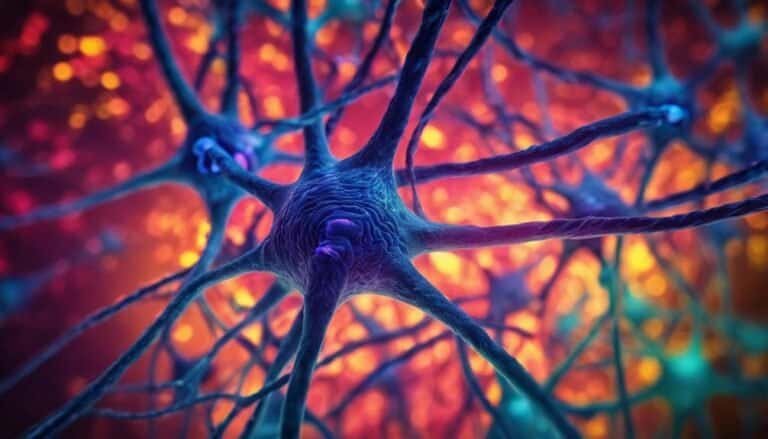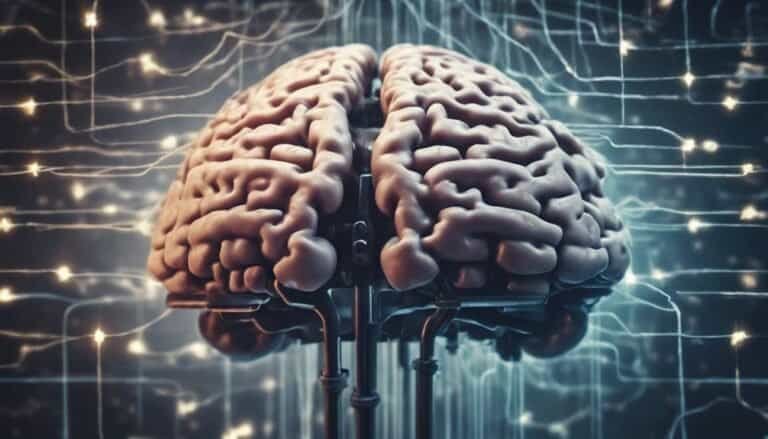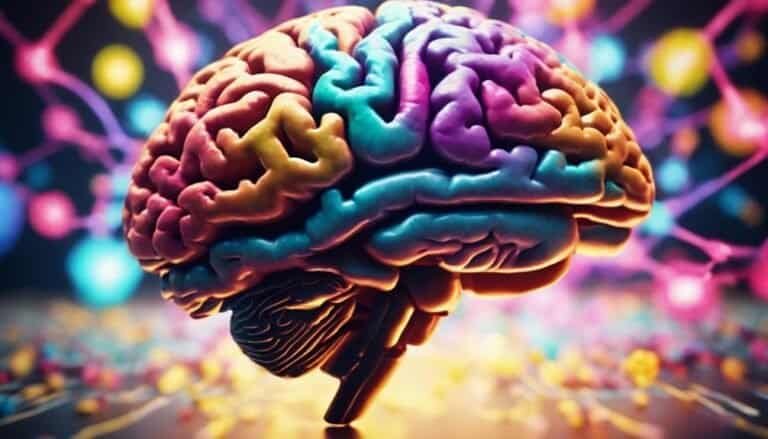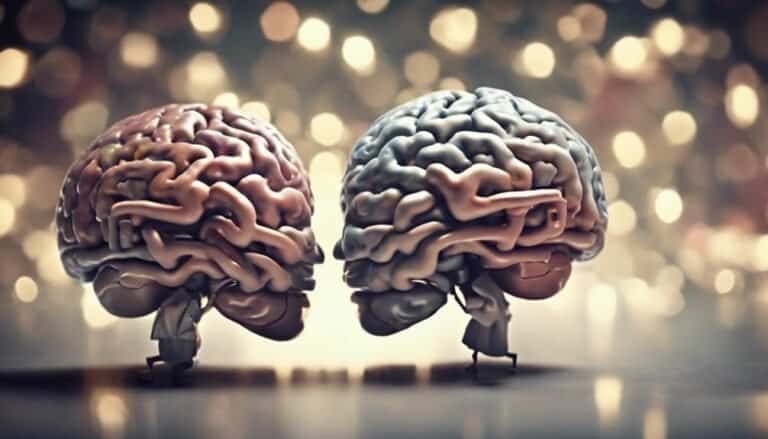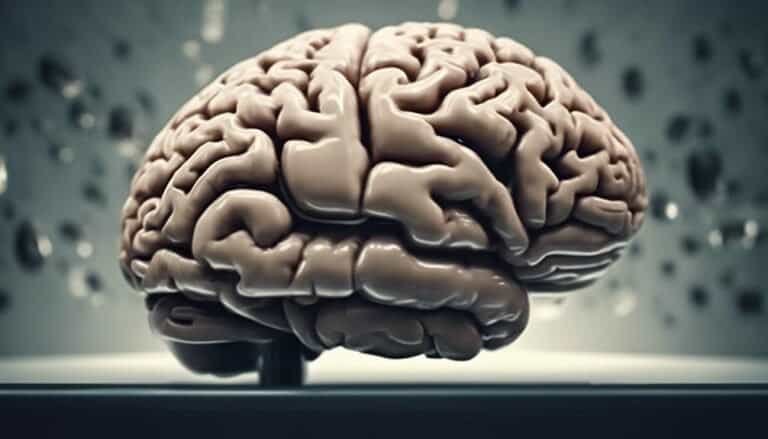Brain's Impact on Team Dynamics
|
Getting your Trinity Audio player ready...
|
As you collaborate with your team, have you ever considered how your brain influences the group dynamic?
The intricate workings of the brain play a crucial role in shaping how teams function and interact.
From decision-making processes to conflict resolution strategies, understanding the neurological basis of teamwork can offer valuable insights into enhancing overall team performance.
Explore the cognitive functions, emotional intelligence, and social hierarchies impacting team dynamics to uncover the fascinating interplay between the brain and effective collaboration.
Key Takeaways
- Neural synchrony in teamwork fosters synergy and effective communication.
- Emotional intelligence enhances conflict resolution and team dynamics.
- Brainstorming techniques and neural plasticity drive innovation within teams.
- Learning connections and neural pathway formation optimize team performance and cognitive flexibility.
Neurological Basis of Teamwork
The brain orchestrates complex neural processes that underlie the intricate dynamics of teamwork. When individuals collaborate, their brains exhibit remarkable synchronization, fostering team synergy. This neural synchronization is pivotal in achieving cohesive teamwork, where members resonate on a cognitive level.
Brainstorming techniques play a crucial role in enhancing this synchronization by promoting active engagement and idea exchange. Through cognitive alignment, team members align their thoughts and actions, leading to enhanced coordination and performance.
Research shows that neural synchronization isn't only crucial for effective communication but also for building trust and rapport within a team. When team members engage in tasks requiring cooperation, their brains exhibit synchronized activity, indicating a high level of coordination and shared understanding. This neural coherence is a key factor in successful teamwork, facilitating smooth interactions and efficient problem-solving.
Cognitive Functions in Collaboration
Cognitive processes play a crucial role in facilitating effective collaboration among team members. When team members engage in cognitive processing tasks, they contribute to the overall success of the group by enhancing problem-solving abilities and decision-making processes. Understanding how cognitive functions operate within a team setting is essential for optimizing group dynamics and achieving common goals.
- Information Processing: Cognitive processing involves how individuals perceive, analyze, and interpret information. In a collaborative environment, team members' ability to process information efficiently influences the group's collective understanding of tasks and objectives.
- Attention and Focus: Maintaining attention and focus is vital for effective collaboration. Cognitive functions such as sustained attention help team members stay engaged during discussions, leading to improved communication and task execution within the group.
- Memory Retention: Cognitive processes related to memory play a significant role in collaboration. Team members rely on memory retention to recall important details, past discussions, and decisions, which contribute to the continuity and progress of group tasks.
Emotional Intelligence in Teams
How does emotional intelligence influence team dynamics and performance?
Emotional intelligence plays a crucial role in shaping the interactions within a team and ultimately impacting its overall performance. One key component of emotional intelligence is self-awareness, which involves recognizing and understanding one's own emotions, strengths, weaknesses, and their impact on others. Team members who possess high levels of self-awareness are better equipped to regulate their emotions effectively, communicate more clearly, and collaborate more efficiently with their peers.
Empathy is another essential aspect of emotional intelligence that significantly influences team dynamics. Empathetic individuals can understand and share the feelings of others, fostering a sense of trust, support, and camaraderie within the team. By empathizing with their teammates, individuals can build stronger relationships, resolve conflicts more effectively, and create a more positive and inclusive team environment.
Brainstorming and Innovation
Engage in collaborative idea generation sessions to stimulate creativity and drive innovative solutions within the team. When brainstorming, the brain's ability to make diverse connections and think outside the box can lead to groundbreaking ideas.
Here are some key points to consider when focusing on brainstorming and innovation:
- Encourage Divergent Thinking: Promote a non-judgmental environment where all ideas are welcome. Creativity sparks from considering a wide range of possibilities without immediately evaluating their feasibility.
- Utilize Visual Aids: Incorporating visual tools such as mind maps or mood boards can help stimulate different areas of the brain and inspire new connections.
- Rotate Leadership: Switching the facilitator role during brainstorming sessions can bring fresh perspectives and idea generation techniques to the table, enhancing the overall creativity of the team.
Conflict Resolution Strategies
To effectively manage conflicts within a team, employ strategic approaches that promote understanding and collaboration among team members. Active listening is a key component in conflict resolution strategies. By actively listening to the concerns and perspectives of others, you demonstrate respect and validate their feelings. This practice fosters an environment where team members feel heard and valued, which is essential for resolving conflicts effectively.
Empathy building is another crucial aspect of conflict resolution. Put yourself in the shoes of your team members to understand their emotions and viewpoints. Showing empathy can help de-escalate tense situations and pave the way for constructive dialogue. When team members feel understood and supported, they're more likely to work together towards finding mutually beneficial solutions.
Social Hierarchies and Team Dynamics
Social hierarchies significantly influence the dynamics within a team, shaping interactions and decision-making processes. Power dynamics play a crucial role in establishing the hierarchy within a team, affecting how individuals communicate and collaborate. Leaders often hold more power, influencing decision-making and setting the tone for the group's interactions. This power dynamic can impact team members' willingness to express their opinions and ideas, ultimately affecting the team's overall performance.
Group cohesion is another key aspect influenced by social hierarchies. The way power is distributed and acknowledged within a team can either foster or hinder group cohesion. When there's a clear and fair distribution of power, group members are more likely to feel valued and connected, leading to stronger bonds and better teamwork. On the contrary, if power dynamics are skewed or unclear, it can create discord within the team, hampering collaboration and productivity.
Hierarchical structures within teams can both positively and negatively affect the team dynamics, emphasizing the importance of understanding and managing power dynamics effectively for optimal team performance.
Decision-Making Processes
The dynamics of social hierarchies within a team significantly shape decision-making processes, influencing how choices are made and implemented. Neural networks play a crucial role in decision-making processes, affecting how individuals perceive information, assess risks, and ultimately choose a course of action. These neural networks are interconnected systems in the brain that process and transmit information related to decision-making. Understanding how neural networks function can provide insights into why certain decisions are made within a team setting.
| Neural Networks | Decision Making Processes |
|---|---|
| Process information rapidly | Influence by social hierarchies |
| Evaluate risks and rewards | Impact of group dynamics |
| Integrate emotions and logic | Implementation of decisions |
Neural networks not only influence individual decision-making but also interact with the social dynamics present in a team, creating a complex interplay between cognitive processes and group behaviors. By studying how neural networks operate in decision-making processes, teams can enhance their understanding of how choices are made and improve their overall decision-making effectiveness.
Neuroplasticity and Team Development
As you explore the concept of neuroplasticity and team development, consider the brain's remarkable adaptive potential in shaping team dynamics.
Understanding the intricate connections between team learning and neural plasticity can unveil new pathways for team growth and collaboration.
The formation of neural pathways within team settings highlights the dynamic interplay between individual brains and collective team behavior.
Brain's Adaptive Potential
Brain's adaptive potential, known as neuroplasticity, plays a crucial role in shaping team dynamics and development. Neuroplasticity benefits teams by enhancing adaptability through modifying neural pathways. To leverage this potential effectively, incorporating cognitive flexibility strategies is key. These strategies enable team members to adjust their thinking patterns, fostering innovative problem-solving and open-mindedness within the team environment.
- Neuroplasticity enhances the brain's ability to reorganize itself based on new experiences.
- Cognitive flexibility strategies help teams navigate complex challenges by encouraging diverse perspectives.
- The adaptability gained through neuroplasticity and cognitive flexibility strategies promotes resilience in the face of uncertainties and changes.
Team Learning Connections
Neuroplasticity's influence on team learning connections is instrumental in fostering adaptive behaviors and enhancing overall team development. Learning connections within a team are crucial for cognitive development and the acquisition of new skills. Through neuroplasticity, team members can reshape their neural pathways, enabling them to learn from experiences, adapt to challenges, and collaborate more effectively.
As team members engage in shared learning experiences, their brains form new connections that support communication, problem-solving, and innovation. This process of cognitive development not only enhances individual capabilities but also strengthens the collective intelligence of the team. By actively participating in team learning activities and embracing neuroplasticity, individuals can contribute to the growth and success of the team as a whole.
Neural Pathway Formation
Neural pathways play a critical role in team development by shaping how team members interact and collaborate effectively. These pathways are essential for memory retrieval and learning retention within the team dynamic. Understanding how neural pathways form and function can provide valuable insights into optimizing team performance.
- Synaptic Plasticity: The ability of synaptic connections to strengthen or weaken based on usage, impacting how information is processed and stored.
- Experience-Dependent Plasticity: Neural pathways adapt and evolve based on team members' experiences, influencing their behavior and decision-making processes.
- Neurogenesis: The formation of new neurons in the brain, which can enhance learning capabilities and overall cognitive function in team settings.
Conclusion
In conclusion, your brain is the conductor of the symphony that's team dynamics. Like a well-oiled machine, each cognitive function plays a crucial role in collaboration.
Emotions are the fuel that propels teamwork forward, while conflict resolution acts as the tuning fork to harmonize divergent perspectives.
Remember, in the intricate dance of social hierarchies and decision-making processes, your brain is the maestro orchestrating the success of your team. Keep nurturing your neuroplasticity to foster continuous team development.


